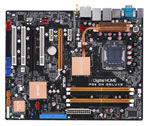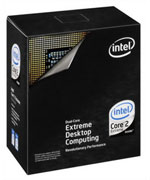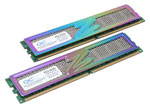Intel Ultra High-End Platform
Finally, we come to the granddaddy of all high-end computer configurations. Oh sure, we could go off the deep end and recommend a dual socket motherboard with Xeon 5160 processors and multiple gigabytes of memory - or you could go out and purchase one of the new Mac systems and get the same thing (minus CrossFire/SLI support) - but outside of workstation class applications a fast single socket configuration will usually offer better performance, and it will save you quite a bit of money.
 |
The MSI motherboard in our basic Intel recommendation is still a good motherboard, and the Abit AW9D and AW9D-Max are another alternative. However, if you want what is considered the best overall 975X motherboard right now, that distinction continues to belong to the ASUS P5W DH Deluxe. Capable of reaching bus speeds of over 400MHz while maintaining stability, and offering full support for 2x8 CrossFire, the ASUS P5W DH has all the features necessary for building an ultimate performance computer. It also fully supports the upcoming Core 2 Extreme QX6700 for those that are planning to upgrade to quad cores in the future. Prices have also come down quite a bit since the initial Core 2 launch, although at $230 the P5W DH certainly isn't an inexpensive motherboard. Thankfully, as the saying goes, you get what you pay for, and what you're paying for here is optimum performance.
 |
When it comes to CPU performance, the Core 2 Extreme X6800 is currently the fastest mainstream processor available. In our initial review, we found that the X6800 didn't lose a single benchmark to any other processor. Similar to AMD's FX series, Core 2 Extreme also comes with unlocked CPU multipliers, so you also gain the benefit of being able to overclock via higher multipliers rather than simply increasing bus speed. (That could prove especially useful if you want to get an nForce4 SLI for Intel motherboard.) If you're interested in achieving maximum performance at any price, you will certainly want the X6800. Just don't get too upset when something faster comes out in the not-too-distant future.
 |
For our ultra high-end configuration, we have pulled out all the stops and gone with some of the fastest memory we have ever tested. The OCZ Titanium VX2 is rated at DDR2-1000, and it is also certified for operation with up to 2.4V. Depending on personal preference, you might also find the chromatic heatsinks to be the best thing ever... or not. In our performance testing, the OCZ VX2 was able to keep up with the best memories currently available. Beyond DDR2-1100, increased latencies often reduce performance making higher clock speeds less useful, but up through DDR2-1067 there are actual performance benefits to be had. Are the benefits worth the extra $150? For a lot of people, the answer is no, but anyone seriously considering a $1000 processor is probably going to want maximum performance in all other areas as well.

 |
Going along with the maximum performance trend, our graphics card selection consists of the recently launched ATI X1950 series, with the obligatory XTX + CrossFire combination. Sporting the same GPU clock speed as the X1900 XTX but utilizing GDDR4-2000 rather than GDDR3-1550, the X1950 is the fastest single GPU currently available. (The GeForce 7950 GX2 is still faster in some situations, but that is technically two GPU cores, and as already mentioned the prospects of upgrading to quad SLI are not without their drawbacks.) ATI's latest driver updates have also further improved performance of all of the R580 cards, with the net result being that X1950 CrossFire is faster than the NVIDIA alternative in most games.
Lastly, we come to the storage subsystem. Anyone looking for even more extreme performance could always add a couple of 150GB Western Digital Raptor drives in RAID 0, but for an ultra high-end computer we prefer more storage over slightly faster hard drives. Thus, we have chosen two 500GB Western Digital hard drives, which you can once again choose to run in RAID 0, RAID 1, or simply as individual drives, giving you up to a full terabyte of storage. You could further upgrade to RAID 1+0 for performance and redundancy, although that would also require four hard drives which is more than most people want to install in a home computer. We certainly aren't recommending this configuration as the best choice for every single person: get what you feel is most beneficial for your storage needs.















45 Comments
View All Comments
limiter - Tuesday, October 10, 2006 - link
I read an article on Toms or HardOCP (that I can't find now) which said they had problems getting one of their DVD drives to work on a P965 ASUS board, but a lot of what I've read comes from Newegg item comments like these for the ASUS P5B Deluxe:For the ASUS P5W DH Deluxe
I've read some other forum comments about DVD problems on ASUS P965 mobos, but I can't find them right now. If I run across them again I will update. I'm not saying this is a bad motherboard or ASUS is a bad company, and any of this could be user error, unrelated bad hardware, or have been corrected by bios updates. I guess I just get the impression there are more people having issues with memory and DVD burners than usual. Nothing I think needs a too much attention. I am happy to see memory was tested for the article, I look forward to the future article mentioned above on this topic!
JarredWalton - Tuesday, October 10, 2006 - link
Of course, all the boards are using 975X in this guide and not P965. The problem likely stems from the fact that none of the P965 boards have an Intel IDE controller, since ICH8 doesn't provide one. (Stupid... but that's a topic for another day.) Most boards use third-party controllers can order to offer IDE support, and some of the initial BIOS revisions were very flaky in memory and IDE support. Beyond that, I can't think of anything specific that would be causing issues for people.JarredWalton - Monday, October 9, 2006 - link
The RAM and motherboard combinations have all been tested (as far as I'm aware) by Gary Key and/or Wesley Fink. Those choices were made with extensive input from Wes and Gary. That's the major sticking point in terms of compatibility - and P965 memory compatibility has improved a lot with the latest BIOS revisions. However, it should be noted that we strongly recommend setting memory timings (and voltages) manually for most high-end enthusiast systems. The SPD settings should work and allow the systems to POST, but they are not optimal by any means. Hope that helps - Gary or Wes might be able to chime in with specific testing results for the RAM+Mobo, although I think there's an article in the works that will cover that aspect regardless.Missing Ghost - Monday, October 9, 2006 - link
Is there really a good reason to choose AM2 over 939? I think the motherboards for 939 are more mature.JarredWalton - Monday, October 9, 2006 - link
If you're looking to use older components (like existing DDR RAM), 939 is still fine. That's what I still use for my personal system (mostly because I don't have the time to get a full Core 2 Duo up and running, and I likely wouldn't notice the difference in performance for the apps I run most). If you're building a full new system, there's no reason to get 939 anymore.Think DDR2 prices are bad? Take a look at quality DDR - it's no better, and you won't get 1:1 overclocks to DDR-667 or higher with any RAM. $250 or so will get you DDR2-800 that can run faster than any 1:1 overclock on AM2 will need. There will also be no future platforms for DDR (other than budget offerings from maybe SiS or VIA).
Anyway, AM2 launched in a state that was nearly as mature as 939, and it has quickly matched it overall, if not exceeded it. The prices are about the same, AM2 typically hold a 5% advantage in performance over 939 (for equivalent CPU and RAM speeds), and hopefully AMD will do quad cores on AM2 in the future - 939 is now EOL'ed, and DDR is in a similar boat. I believe the last production runs of DDR will complete in early 2007, and then pretty much everything will shift to DDR2 or later RAM production.
mostlyprudent - Monday, October 9, 2006 - link
Wow! You really covered your bases and made it clear that there are still plenty of options out there to choose from. Nicely done, although it leaves little room for discussion.One Guide I would love to see in the future is one that attempts to find the best balance between noise and performance. There are plenty of sites that talk about silencing a PC, but they tend to cripple performance at some level. Anandtech has looked at some components in this respect (i.e. video cards and cases), but it would be great to see the whole package put together. Maybe it's in the context of the best all-purpose PC for those who cannot afford a separate rig for gaming, one for family use, one for an HTPC, a media server, etc.
MadBoris - Monday, October 9, 2006 - link
Glad you guys offered so many alternatives through the guide. I like a reference of what the current best components are in each field, but I end up choosing certain best components. So the alternatives, throughout the guide, were very nice.Thanks for these buyers guides, it will really help alot of people out with core 2 duo upgrades and upcoming next gen GPU's. Thanks alot guys.
Baked - Monday, October 9, 2006 - link
What's with the Ultra High End system w/o a Seasonic or PCP&C PSU?And no loving for the Thermalright Ultra-120? Unlike other companies, Thermalright knows how to innovate instead of just blowing up their products. You can get the Ultra-120 w/ a Yate Loon D12L for less than $55 and it'll perform better if not on par w/ the Scythe Infinity, AND it'll stay attached to the motherboard. You expect people to buy your $65 but you can't come up w/ a better mounting system other than the one used by Intel's retail HSF? Poleeeeeeeese.
JarredWalton - Monday, October 9, 2006 - link
See above comment - the Kingwin has been upgraded to a Seasonic S12-500 now. I should have figured the PSU police would come knocking if I didn't spend at least $100 on a "high-end" PSU. Honestly, if you don't plan on overclocking and adding a lot of extras, the vast majority of 500-600W PSUs will work fine. Some are quieter, some are more efficient, but most will handle a moderately high-end configuration.BTW, I'm typing this on a system configured with:
ASUS A8R32-MVP
Athlon X2 3800+ OC'ed to 2.2GHz (4600+ equivalent)
X1900 XT + X1900 CF GPUs
2x1024MB OCZ DDR-500 3-3-3-8-1T
320GB WD HDD
160GB Samsung HDD (secondary storage)
Pioneer DVR-110D
Antec SLK-3000B case
...And a Kingwin 600W PSU
I bought the Kingwin several months ago on a whim - I needed a PSU fast after an Antec 400W unit failed, and the local shops didn't have a great selection. Note that the Antec PSU was *not* used in this system config! LOL - CrossFire on an Antec? Not for me!
The system is not extremely quiet... but then that's almost impossible with dual X1900 cards. Full load the system stays well under 500W, and I haven't had any issues with stability whatsoever. Upgrading the system to socket AM2 and 7900GTO cards would drop power requirements, so I still fully stand by the original choice of the 600W Kingwin as a reasonable "budget high-end" PSU. Will it fail gracefully if I exceed the limits of the PSU? No idea - I don't intend to find out either. :)
yyrkoon - Tuesday, October 10, 2006 - link
Its not about the brand name Jarred, you can find a reasonable PCP&C PSU, hell, you'll pay more just because of SLI 'certification'. Anyhow, sometimes, someone may want a longer hold time, or want rock solid rails, or possibly better efficiency (although seasonic may have PCP&C beat here, depends on models).You mentioned something about re-branding, however im not so sure thats completely true. 99.9% of all PSUs probably are made in one of 12 plants in China, HOWEVER, parts, support, , and specifications are not always interchangeable.
I didnt see how much your KINGWIN PSU was, but something that hits me as more than slightly funny, is why spend 260 us on a motherboard, 300 + on a CPU, 250-300 on memory, and get cheap on the PSU ? I think you'll find that PCP&C PSUs are more efficient, have a much longer hold time, and should exibit a much more solid rail supply. Lets not forget that PCP&C PSUs are rated at 40C, and not 25C like alot of common PSUs on the market. (not everyone lives where its cold, or even cool.)*shrug*